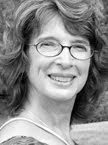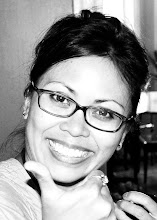By Deborah McLeod
Barbara Bernstein is a resident fellow at the VCCA in San Angelo, VA, and an adjunct professor of sculpture at RISD several days out of the week. Barbara works in a grand scale skewed-perspective, and highly elaborate drawing mode that borrows from and integrates Eastern and Western traditions.
In her recent site-specific solo installation at Hollins University,"Things are not what they seem, nor are they otherwise" she used black tape and white foamcore to "draw" the historic Hollins campus as a compelling 3-D trompe l'oeil environment.
In her current show, Patterns of Love and Beauty, at Riverviews Artspace, she integrates interior and exterior scapes in an homage to her dying father. Bernstein's work explores counter valances; simplicity and complexity, weight and lightness, foreground and aft, stillness and action. Speaking to me in her apartment workspace, amongst countless marker drawings, pencils and paper collages she shares some of her processes.


DM-Can you give us a little back story into how your paint and ink drawings have evolved from two to three dimension. What initiated that direction?
BB-It really started with two subsequent events. The first was looking at Jackson Pollack's " Autumn Rhythm" many years ago. I first saw "Autumn Rhythm" as a child of about ten. Growing up in New York City I visited museums at an early age. The feeling of looking at that large canvas was the awareness of being tremendously encompassed. I came to find myself understanding that I what I really wanted was to be a participant in a drawing instead of an observer. My wall-sized black and white drawings began to get thicker - often with encaustic - in my evolving attempt to create an environment. But it was something I couldn't really afford. Receiving the Pollack Krasner award in 2002 - was when I was finally able to afford the wall sized reams and rolls of beautiful, sturdy BFK paper that would allow me the luxury of working on that encompassing effect.
DM-Pollack Krasner has come to so many artists’ rescue! Was there a specific threshold work for you before or after that, pushing you outwards into the gallery space and seizing your objective?
While working on a 9'x5'wide drawing with primarily vertical marks that was feeling unresolved, I found a discarded remnant of long rubber cable on the street. It was the line I had been looking for. The pliant rubber cable became my line that reached through space - I attached it near the top of the drawing so that it arced out into the room, reflecting the drawing's existing marks to encompass the room and the viewer. A year or two after that piece I got the Pollack-Krasner. Really, I fell to my knees when I got the Pollack-Krasner phone call and cried.
DM-What subtle discoveries have you made by staying purely with black and white?
BB-I'm still learning from black and white. It was and is power, and mystery. I'm fascinated by what happens to space when a single mark is introduced. My somewhat limited understanding of Japanese aesthetics has particularly led me to appreciate the mystery of the space in between.
DM-Do you see this happening in the standard terms of negatives and positives?
BB-Negative space isn't, it has presence and weight. The mutual dependency of black and white is for me - presence and presence. They co-create each other, like the inside and the outside of a teacup. I have learned that in simplicity whole worlds are revealed. That is a lesson found in the study of Asian art has been particularly impactful. In high school I encountered a Zen garden at the Huntington Gardens in Southern California. I remember the palpable shift being in that space, a simultaneous quietude and
largeness.
DM- And do you see a relationship between the Zen aesthetic and Pollack's Autumn Rhythm?
BB-Pollack offers a different kind of silence, it is instead the situation of being awed into silence. The brain must stop talking.
DM-You've just closed your Hollins installation on the history of the campus and have one going on now at Riverviews.What do you have coming up on the horizon that you are working towards?
BB-Two coming up...a solo installation in spring of 2010 in the Babcock Gallery at Sweet Briar College. And, as a result of the Riverviews show, the Lynchburg Neighborhood Development Foundation offered me an old corner service station - conveniently already painted black and white! I will begin next week drawing on its 9' plate glass windows.
DM-It seems that many of your recent installations are dealing with selective landscape, the process of emphasizing extant symbolic landscape features, while omitting others, on behalf of emotional impact and spatial silence. Would you comment on that?
BB-Perhaps it was because of being born in New York or despite it, the landscape and particular trees offer a quietude and expansiveness that is comforting to me, engaging and mysterious in their movement and presence. This holds true for me whether its images are from Eastern or Western art or simply from being in the woods. DeKooning talked about "glimpses" and being a "shifting glimpser". I like the idea of holding fast and letting go simultaneously.

DM-Tell me about your residency at the VCCA. How did that come about for
you and your husband? And how has that experience impacted the development
of your ideas?
My husband, David Garratt, and I were both VCCA fellows in late in 2007. At
that time a number of other fellows asked us to become the Resident Artists.
It is essentially an unpaid staff position. In exchange for housing in this inspiring place my husband works on the building and grounds, and I work in the kitchen. We are on call 24/7 as first responders. Unlike the resident fellows who come there for seamless time with their work. I work in components of time around my duties. It has changed how I work, I balance my hours and occasionally my media. I often do collages to take me to a more flexible, fluid almost frivolous place. If I just can say...fun.
.jpg)





